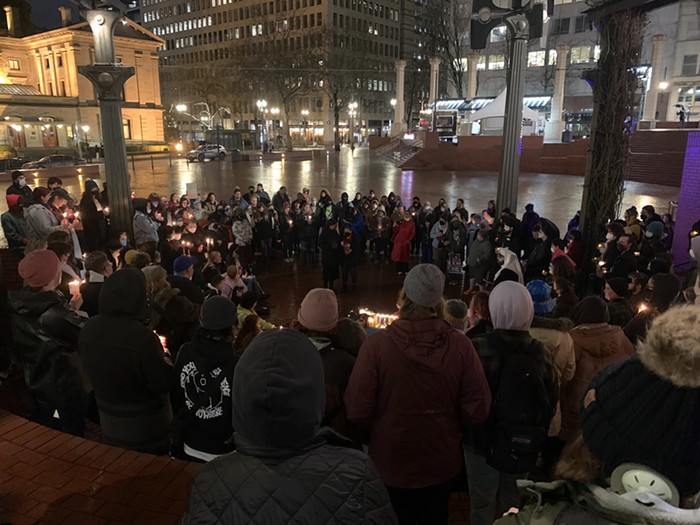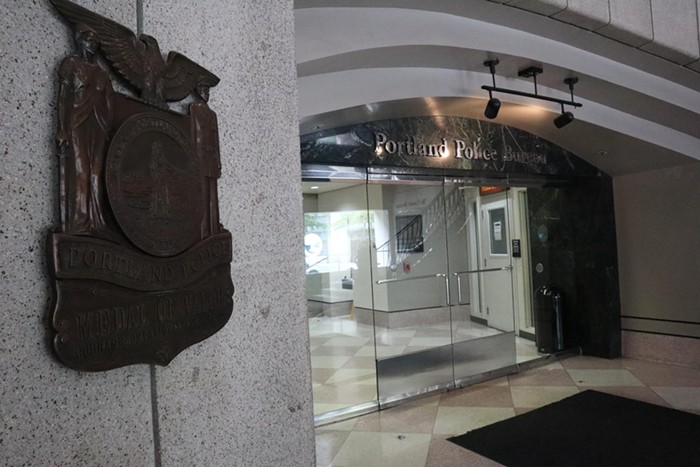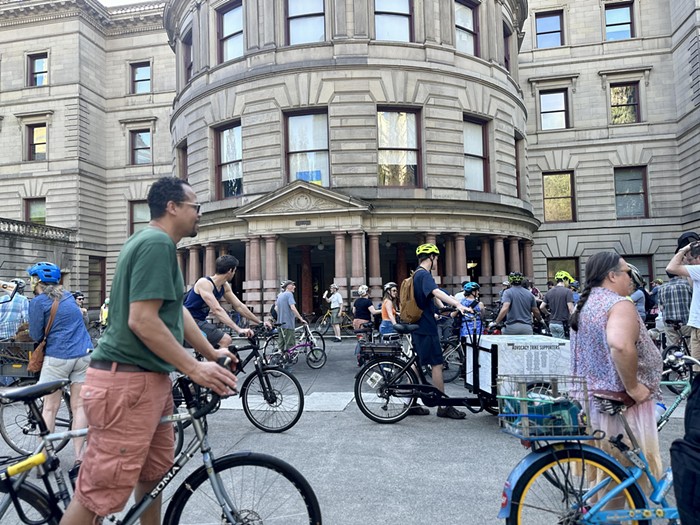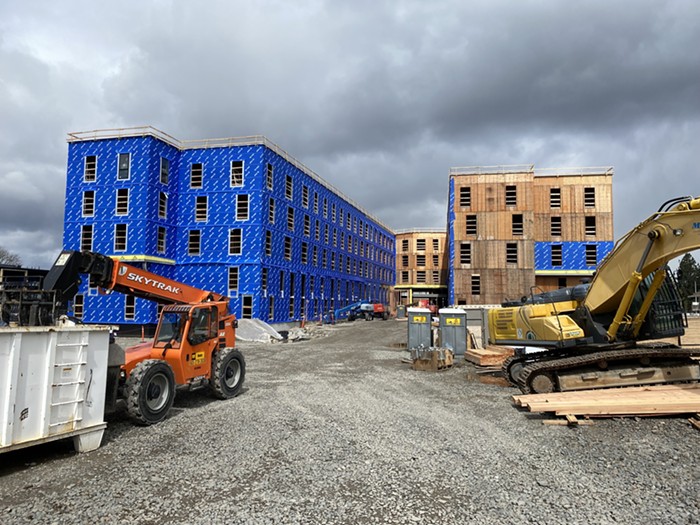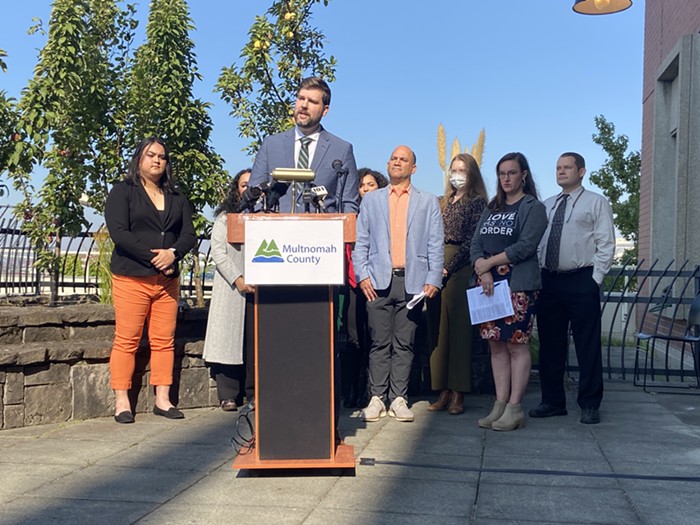PETE OWENS lights another cigarette, happy to be feeling well enough to enjoy it.
Not long ago, Owens was sick. He's been homeless on and off for the last seven years, and knows the ailments that can come with that difficult lifestyle. He says this was different.
"It was bronchitis," Owens said last week, sitting on a bed raised off the ground by plastic milk cartons, in a little cluster of tents connected by a series of tarps. "I couldn't shake it."
Then he says: "It's because I was using the fill dirt."
See, Owens recently found a new plot of land to call home.
Until early May, he'd been one of the many people sleeping each night off the Springwater Corridor—"the bike path" as he calls it—accustomed to regular hassles and an ever-present fear of having his stuff stolen. Then, just before authorities carried out a massive sweep near where the path crosses SE 82nd last month, Owens says he got word of a better property.
Advocates, at the city's behest, steered him north and a little east, to a five-acre plot of public land near SE 105th and Reedway long used as a dumping ground for soil removed from around Johnson Creek.
It was filthy when Owens arrived, he says: festooned with needles and trash, and smelling "like human shit." But Mayor Charlie Hales' office sent along a dumpster and portable toilet. A mayoral intern brought water. Owens and other homeless residents cleaned up the property, and even set about filling in uneven patches of ground with soil piled up at the site.
Which is about when Owens and one of his fellow campers began feeling unwell.

"I thought it was just concrete," he says of prominent, pale mounds of earth that have sat on the property for years. "They told us to stop spreading it. Everywhere we spread it, they said they're going to have to decontaminate."
Public documents show why that might be the case. The quiet site where Owens has been thankful to stay for the past five weeks or so is piled high with contaminated soil—some of it potentially threatening to human health.
Among more than a dozen small piles that the city says have been illegally dumped there over the years, there are mounds containing enough of some carcinogens (chemicals with unwieldy names like Benzo[a]pyrene and Indeno[1,2,3-cd]pyrene) to exceed state safety standards for residential soil. Far larger piles of earth—placed by the city over the years—don't qualify for use as fill in residential construction because of elevated lead (though it's likely not enough to affect human health).
In total, a 2014 environmental assessment of the site found, a little less than half of the 22,000-plus cubic yards of dirt piled at the property is considered contaminated.
What's more, a study from 2000 found soil on the site contained arsenic levels above state and federal safety standards for residential sites.
Those findings have some advocates fuming.
"Maybe they should have gotten an informed consent signature from the campers" before placing them there, says Trena Sutton, who works with homeless people along the Springwater through the Clackamas Service Center.
The situation at the plot of land—called the "Kalbrenner Property" in city documents—reflects a central difficulty of Hales' ambitions to set up a system of organized camps throughout Portland: Namely, it's really hard to find workable real estate.
That's especially true near the Springwater, the single most complex area officials working to ease the city's homelessness crisis are dealing with. A good amount of city-owned land along the trail belongs to the Portland Bureau of Environmental Services (BES), which is run by Commissioner Nick Fish. And Fish, a former housing commissioner, has made plain his qualms with Hales' homelessness strategy, and his reservations about opening up environmentally sensitive land to campers.
The one possible exception is the Kalbrenner Property, with its contaminated dirt heaps.
Fish has authorized BES to enter into an agreement with the Portland Office of Management and Finance. Signed June 2, the memorandum [PDF] outlines a path for the bureaus to study how feasible an organized camp might be.
"We saw this was a possibility and the commissioner authorized the beginning of a due diligence on it," says Jim Blackwood, a policy director for Fish. "This is the only [property] that we're giving any active consideration to."
Paramount for BES, which is grappling with a lawsuit over how it's spent ratepayer money in the past, is that it won't pay a dime for any improvements or work associated with housing people on the site, Blackwood says. Prior to talking to the Mercury, he hadn't heard about campers feeling sick after using contaminated soil.
"If everything else works for us and them and they have to remove that soil," he says of the office of management and finance, "they have to figure out how to get rid of it."
According to their new agreement, the bureaus "will jointly investigate the risks and possibilities of using the property as a site to shelter temporarily persons who may be homeless." The document references "potential environmental and human health risks due to contaminated soil."
"The only material on site that is considered a threat to human health is from some of the illegal dump piles," says Linc Mann, spokesperson for the BES.
Of course, the possible problem is that there are humans living there, among those dump piles, with tacit city approval. Owens and other campers on the plot—there are roughly nine—say Hale's office has given them the green light to stay. They're supposed to keep out of sight, and won't let anyone else set up on the land while studies are carried out.
Mike Davis, who's worked with homeless people along the trail, confirms he steered Owens and others there, at the instruction of the mayor's office. Hales' employees, though, downplay that.
To be clear, Owens and his campmates aren't complaining. They like living on the Kalbrenner Property, for the most part—at least more so than they liked the bike path.
"The path, that was a hassle," Owens says, as a campmate begins playing music on a cell phone. "It's nice and quiet here."
And in Portland—at least right now—there aren't many better options.
"The people would live inside a nuclear reactor to avoid being swept," says Sutton, the advocate with Clackamas Service Center. "They should have been informed."
